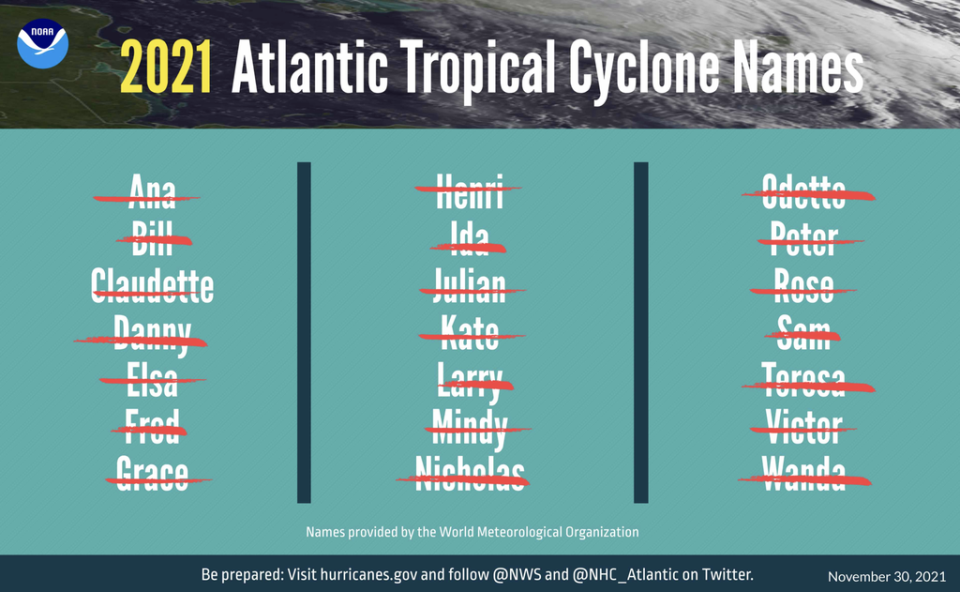Another extreme hurricane season is officially over. Here’s what we learned
Atlantic hurricane season officially ended on Tuesday and while the number of named storms did not reach the record-breaking levels of 2020, the impacts nevertheless were catastrophic.
The Atlantic Ocean still had an above-normal number of hurricanes in 2021, for the sixth year in a row. It was also the third most active season since record-keeping began in the mid-19th century.
For the seventh consecutive year, the first-named storm - called Ana - kicked up ahead of the official start to the season on 1 June. And 2021 is only the third time that every name on the official list allocated by the National Hurricane Center could be scratched off, ending with Tropical Storm Wanda last month.
In total, there were 21 named storms including eight which made landfall in the United States. Four were extreme storms, two which reached Category 3 and two of Category 4.
The tail-end of August brought major devastation in the form of Hurricane Ida which made landfall near New Orleans as a Category-4, lashing the region with winds of up to 150mph (240kph), and several feet of storm surge, on the 16th anniversary of Hurricane Katrina.

Mercifully, levees held around the Big Easy after being reinforced in the wake of 2005’s Katrina which decimated neighbourhoods and left 1,800 people dead. However Ida still caused massive flooding in communities like Houma and LaPlace along with widespread damage to Louisiana’s power grid. Millions of people were left in blackout as temperatures soared into triple digits.
The remnants of the hurricane then shifted up the East Coast bringing dangerous flash flooding and tornadoes from eastern Pennsylvania to New York City.
Flash flood emergencies were declared in New Jersey and New York for the first time leaving homes, businesses and the subway system submerged. In all, there were 96 fatalities across the US. A number of people died in the Northeast after drowning in basement apartments and in cars that were swept away.
Due to the severity of Ida, the 2021 hurricane season is likely to be one of the costliest on record, reaching more than $70bn in damages. A total of 161 people died across all storms.
Scientists have long-warned that the climate crisis is fuelling more powerful and destructive storms.
The latest report from the Intergovernmental Panel on Climate Change, the world’s leading authority on climate science, found that storms with sustained higher wind speeds – in the Category 3-5 range – have likely increased in the past 40 years.
While it’s still unclear whether climate change will increase the number of hurricanes, rising global temperatures will likely make the storms we do experience more powerful and more destructive. Five storms in 2021 - Elsa, Grace, Ida, Larry and Sam - saw rapid intensification, the National Oceanic and Atmospheric Administration (NOAA) reported on Tuesday.
The ocean absorbs over 90 per cent of excess heat caused by greenhouse gas emissions from the burning of fossil fuels and that warm water feeds into hurricanes.
“There is more energy available, so intensification of these hurricanes is expected,” Dr Susan Lozier, president of the American Geophysical Union and an expert on the interaction of oceans, hurricanes and climate change, told The Independent in September. “And intensification brings more winds.”
Another cause for concern is that as the planet heats up, more moisture is held in the atmosphere, meaning storms hold the potential of a lot more rainfall.
“Within about 150km of the storm centre, we expect average rain flux rate to increase about 7 per cent for every one degree Celsius of global warming,” Dr Tom Knutson, senior scientist with the NOAA Geophysical Fluid Dynamics Laboratory, previously told The Independent.
Global sea level rise is compounding the danger of storm surge. On the US East Coast, for example, the sea is rising by about one inch every three years.
Dr Astrid Caldas, a senior climate scientist at the Union of Concerned Scientists, noted in a blog post on Tuesday that Ida was just one of seven storms in the Gulf of Mexico in 2021 and highlighted new research which found that Florida and Louisiana may now be more prone to such extreme events.
“Under a high-emissions scenario — meaning if we keep pumping unabated heat-trapping emissions in the atmosphere —the study found that most coastal regions of the US had an increasing potential for sequential landfalling tropical cyclones (tropical storms and hurricanes) since 1979, but that Florida and Louisiana are more likely than most regions to experience such a phenomenon,” Dr Caldas wrote.
Read More
World’s largest carbon-sucking factory starts operation in Iceland
‘The climate crisis is a reality’: Africa’s summer of extremes
Against the odds: The fight to save sea turtles in Ras Baridi
Plastic waste bringing species into marine ecosystems ‘undisturbed for millennia’
Video shows polar bear drowning reindeer as climate crisis intensifies food struggle

